
Publisher:
Bonnie King
CONTACT:
Newsroom@Salem-news.com
Advertising:
Adsales@Salem-news.com

~Truth~
~Justice~
~Peace~
TJP
Sep-13-2007 09:26

 TweetFollow @OregonNews
TweetFollow @OregonNews
Oregon Scientists to Study Harmful Algal Blooms
Salem-News.comPhytoplankton blooms are a normal ocean process, critical to maintaining the productive marine food web off the Pacific Northwest coast.
 Scientists track harmful algal blooms, which cause toxins to accumulate in filter-feeding shellfish such as mussels. Photo courtesy: Oregon State University |
(NEWPORT, Ore. ) - A team of Oregon scientists has received a grant from the National Oceanic and Atmospheric Administration to begin monitoring harmful algal blooms off the coast, and responding to these events as they occur.
The five-year, $2.3 million grant will bring together researchers from Oregon State University, the University of Oregon, and the Oregon Department of Fish and Wildlife to develop a program they hope will better protect the public from two species of toxic algae, and reduce closures of razor clam harvests along the Oregon coast.
The group will work closely with NOAA scientists at OSU’s Hatfield Marine Science Center in Newport, as well as in Seattle and Monterey, Calif., and with the Oregon Department of Agriculture, which tests for toxin levels in coastal shellfish and makes decisions on closures.
“We already have done a lot of the background science that helps us to understand the nature of these harmful algal blooms,” said Peter Strutton, an assistant professor in OSU’s College of Oceanic and Atmospheric Sciences and one of the lead researchers on the project. “Now the goal is to do a full-out response when these blooms occur and to determine what triggers the toxicity in the phytoplankton.
“Ultimately,” he added, “this should allow us to more rapidly detect when these toxic events occur, and hopefully it will lead to the ability to use satellites to identify and track harmful algal blooms in general.”
Phytoplankton blooms are a normal ocean process, critical to maintaining the productive marine food web off the Pacific Northwest coast.
Spring and summer winds bring up cold, deep water that is nutrient-rich to the ocean surface in a process called “upwelling.”
When that water is exposed to sunlight, it creates blooms of phytoplankton. These tiny plants are a source of food for zooplankton and other marine creatures, which in turn are feasted upon by larger animals.
But certain species of phytoplankton have the ability to produce toxins that can be harmful to humans.
One called Pseudo-nitzschia produces domoic acid, which bio-accumulates in the tissues of razor clams, mussels and oysters and causes a syndrome known as amnesic shellfish poisoning in humans.
Another species, Alexandrium, produces saxitoxin, which can lead to paralytic shellfish poisoning if ingested.
“Clams and other shellfish take in the toxins when they filter water and the toxin level can vary for a number of reasons,” said Michelle Wood, a professor of biology at the University of Oregon and a member of the research team. “Mussels lose their toxicity quickly, in a matter of days. But razor clams incorporate the toxin in their tissue and remain toxic for weeks, even when they are no longer consuming toxin-producing food.”
Razor clam closures due to these harmful toxins come with a cost. The Oregon Department of Fish and Wildlife estimated that a domoic acid-related closure of razor clamming at Clatsop Beach alone in 2003 cost local communities an estimated $4.8 million.
“That’s probably a conservative estimate,” said Matt Hunter of ODFW, “but it illustrates the scope of the issue.” Harmful algal blooms have resulted in closures of the entire Oregon coast at times over the past few years, he added.
Of course, not all phytoplankton blooms are toxic, Strutton pointed out, and even the species that are potentially toxic don’t always produce toxins.
“We’re not sure what causes phytoplankton to suddenly become toxic,” he said. “Some scientists believe it may be stress from a lack of nutrients; it also has been suggested that the toxins bond to necessary trace elements such as iron as a way for the phytoplankton to ‘capture’ these nutrients. There has been some work on this off of Washington, which we hope to incorporate into this NOAA study.”
As part of the project, the scientists will use programmed undersea gliders to monitor ocean conditions during harmful algal blooms to determine whether temperature, salinity, chlorophyll levels, oxygen levels or other factors may contribute to toxicity.
They also will study coastal currents and winds in an effort to better predict when these toxic blooms may come ashore and affect clams and other shellfish.
More information on the project is available online at: www.coas.oregonstate.edu/habs
Articles for September 12, 2007 | Articles for September 13, 2007 | Articles for September 14, 2007



googlec507860f6901db00.html


Terms of Service | Privacy Policy
All comments and messages are approved by people and self promotional links or unacceptable comments are denied.
[Return to Top]
©2025 Salem-News.com. All opinions expressed in this article are those of the author and do not necessarily reflect those of Salem-News.com.